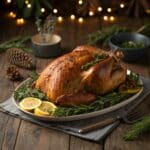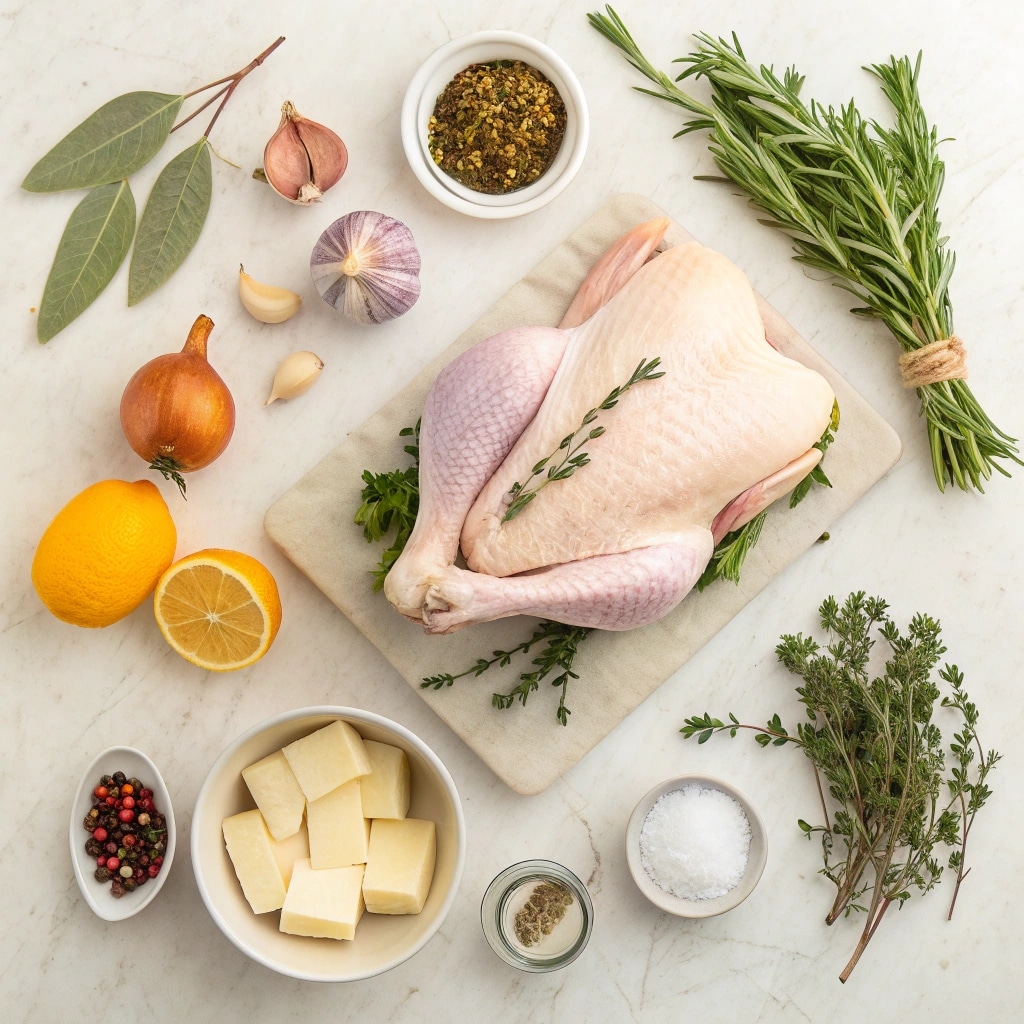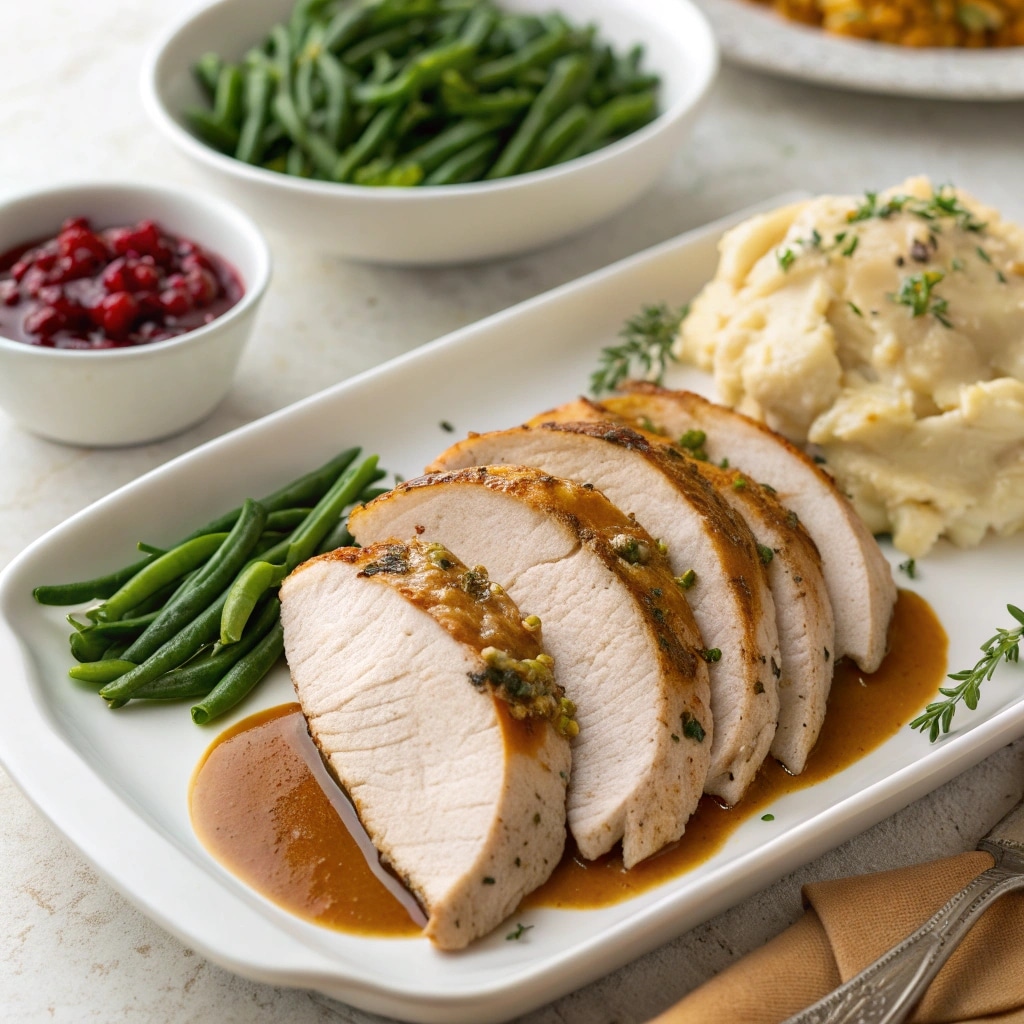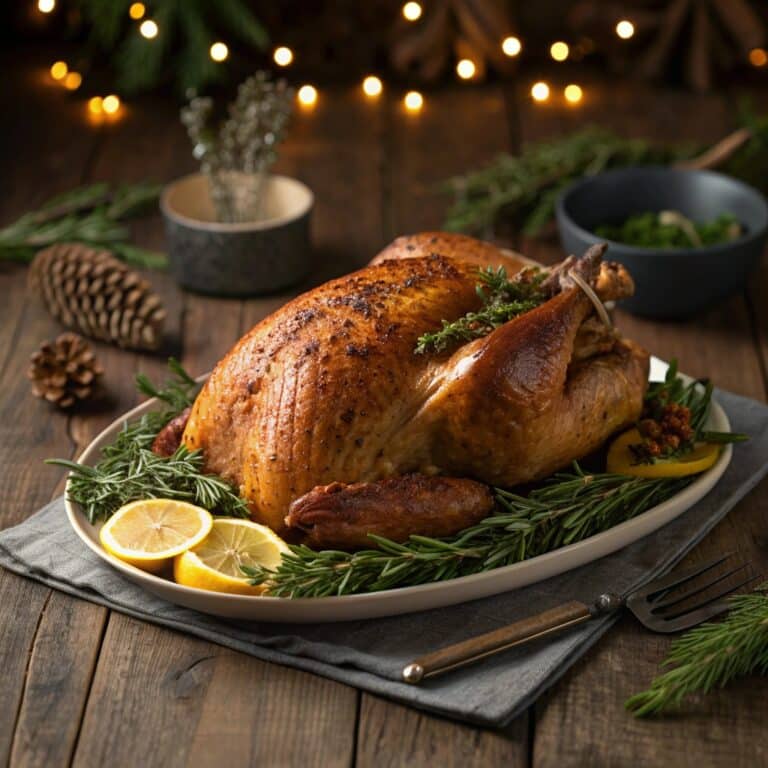If there’s one dish that always makes the holidays memorable, it’s a Juicy Herb-Roasted Turkey. This recipe is more than just the centerpiece of the table it’s about creating a flavorful, tender bird that everyone looks forward to. In this article, I’ll share the steps to achieve that perfect balance of crispy golden skin and juicy, herb-infused meat. From prepping with fresh herbs to mastering oven techniques, you’ll learn everything you need to serve a turkey that tastes as good as it looks. Let’s start with the story behind this recipe and why it means so much in my kitchen.
Table of Contents
The Story & Why This Recipe Matters
From My First Turkey to This Recipe
Hi there! I’m Clara, the heart and soul behind Recipebyclara.com. From my earliest memories, the kitchen has always been a place of warmth and creativity. I still remember the first time I attempted a holiday turkey it came out a little too dry, and carving it was more of a challenge than a joy. But that experience set me on a path of learning how to master the art of roasting. Over time, I discovered that patience, the right combination of herbs, and a few simple techniques can completely transform the outcome. That’s how this Juicy Herb-Roasted Turkey was born through trial, error, and the desire to create a dish that feels as comforting as it is impressive.
What Makes a Herb-Roasted Turkey “Juicy”
The secret to a Juicy Herb-Roasted Turkey lies in moisture and flavor working together. I learned early on that simply seasoning the outside of the bird wasn’t enough. By carefully drying the skin, rubbing a herb butter under and over the surface, and seasoning the cavity with aromatics, you ensure every bite is infused with flavor. Fresh herbs like rosemary, thyme, and sage bring out earthy, savory notes that balance the richness of the meat. Roasting at the right temperature locks in juices while allowing the skin to crisp to golden perfection. It’s a method that consistently delivers juicy meat, crispy skin, and unforgettable flavor.
Print
Juicy Herb-Roasted Turkey
- Total Time: 4 hours
- Yield: 12 servings
Description
A holiday classic, this Juicy Herb-Roasted Turkey delivers golden, crispy skin and tender, flavorful meat infused with fresh herbs and butter.
Ingredients
- 1 whole turkey (12–14 lbs), thawed
- 1 cup unsalted butter, softened
- 4 cloves garlic, minced
- 2 tablespoons fresh rosemary, chopped
- 2 tablespoons fresh thyme, chopped
- 2 tablespoons fresh sage, chopped
- 2 teaspoons kosher salt
- 1 teaspoon freshly ground black pepper
- 1 onion, quartered
- 1 lemon or orange, halved
- 2 celery stalks
- 2 carrots
- Extra fresh herbs for cavity
Instructions
- Preheat oven to 325°F (160°C).
- If desired, brine turkey overnight (wet or dry brine).
- Pat turkey dry thoroughly with paper towels.
- Mix softened butter with garlic, rosemary, thyme, sage, salt, and pepper.
- Loosen turkey skin over breasts and thighs, spread herb butter under skin and over entire bird.
- Stuff cavity with onion, citrus halves, celery, carrots, and herbs.
- Place turkey breast-side up on a roasting rack inside a large pan.
- Roast 15 minutes per pound (about 3 ½ hours for 14 lbs).
- Baste with pan juices every 45 minutes if desired.
- If skin browns too quickly, tent with foil.
- Check doneness: breast at 160°F, thigh at 175°F.
- Rest turkey 30 minutes before carving.
Notes
Resting is essential for juicy slices. Save pan drippings for homemade gravy.
- Prep Time: 30 minutes
- Cook Time: 3 hours 30 minutes
- Category: Main Course
- Method: Roasting
- Cuisine: American
Ingredients & Prep Strategy
Key Ingredients That Elevate Flavor
The best Juicy Herb-Roasted Turkey starts with simple, high-quality ingredients that work together to enhance flavor and tenderness. A whole turkey, preferably fresh and not pre-seasoned, is the foundation. Unsalted butter is key for creating that rich, golden skin it melts into the meat while carrying herbs deep into the flesh. A blend of rosemary, thyme, and sage forms the classic trio that defines herb-roasted poultry. Garlic and onion bring aromatic depth, while lemon or orange adds brightness that cuts through richness. Don’t forget kosher salt and freshly cracked black pepper these basics help the flavors shine. For the cavity, adding celery, carrots, and fresh herbs infuses the turkey from the inside out, making every slice more flavorful.
Prepping the Turkey: Brining, Drying & Buttering
Preparation is just as important as the roasting process itself. Start by thawing your turkey completely in the refrigerator plan one day for every four pounds. For extra moisture and flavor, many cooks use a simple wet or dry brine. A wet brine involves soaking the turkey in a salt solution overnight, while a dry brine is rubbed directly onto the skin and left uncovered in the fridge. Both methods help the meat absorb seasoning and retain moisture during roasting. Once brined, pat the turkey dry thoroughly. This ensures the butter and herbs stick and also helps achieve crisp skin.
Next, prepare an herb butter by mixing softened butter with minced garlic, chopped fresh herbs, salt, and pepper. Carefully loosen the skin over the breast and thighs with your fingers, then spread the butter underneath and over the surface. This step locks in flavor and ensures the turkey roasts to juicy perfection with an irresistible golden crust.

Roasting Techniques for Perfect Results
Oven Temperature, Placement & Timing
The success of a Juicy Herb-Roasted Turkey depends on controlling oven temperature and positioning. Start by preheating your oven to 325°F. This steady heat allows the meat to cook evenly while giving the skin time to turn golden and crisp. Place the turkey breast side up on a roasting rack set inside a large roasting pan. The rack is crucial it keeps the bird elevated so air circulates evenly, preventing soggy skin and allowing drippings to collect for gravy. Cooking time varies based on weight, but plan for about 15 minutes per pound. For example, a 14-pound turkey takes roughly 3½ hours.
Check at the halfway mark to ensure the skin is browning evenly. If one side cooks faster, rotate the pan. This simple step helps maintain consistent roasting from start to finish.
Basting, Tent Foil & Monitoring Doneness
Basting can be optional, but if you love the ritual, spoon pan juices over the turkey every 45 minutes. This adds flavor but won’t make the turkey juicier on its own the herb butter under the skin does most of the work. If the skin browns too quickly, lightly tent the breast with foil to prevent burning while the rest cooks through. The most reliable way to confirm doneness is with a meat thermometer. Insert it into the thickest part of the breast and thigh, avoiding bone.
The breast should reach 160°F and the thigh 175°F. As the turkey rests, the temperature will rise slightly, hitting the USDA-recommended 165°F for food safety. Rest the turkey for at least 30 minutes before carving. This pause allows juices to redistribute, ensuring moist, tender slices every time.
Serving, Leftovers & Troubleshooting
Carving, Serving & Gravy Ideas
Once your Juicy Herb-Roasted Turkey has rested, it’s time to carve and serve. Start by removing the legs and thighs, then slice along the breastbone to separate the breast meat. Cutting against the grain ensures each slice is tender. Arrange the turkey pieces on a large platter and garnish with fresh herbs and citrus slices for a festive touch. Don’t forget the drippings left in the roasting pan they’re the base for a rich, flavorful gravy. Deglaze the pan with chicken broth, whisk in a little flour or cornstarch slurry, and season to taste. This homemade gravy pairs beautifully with mashed potatoes, stuffing, or roasted vegetables, tying the meal together in one delicious bite.
Common Problems & Fixes
Even with the best preparation, turkey can sometimes be tricky. If the breast meat turns out slightly dry, serve it with extra gravy or slice it thin to keep it tender. If the skin doesn’t brown evenly, brush on a little melted butter and return the turkey to the oven uncovered for a few minutes. Uneven cooking often comes from a partially thawed bird or incorrect oven placement, so always check both before roasting. If the turkey is done early, cover it loosely with foil and a towel to keep it warm for up to an hour without losing juiciness. For leftovers, store carved turkey in airtight containers with a splash of broth to prevent drying out.
Use it for sandwiches, soups, casseroles, or even salads it’s a versatile ingredient that makes post-holiday meals easy and satisfying.
With these tips, your Juicy Herb-Roasted Turkey will not only shine on the holiday table but also keep feeding your family with delicious possibilities afterward.

FAQs
How do you keep a turkey juicy while roasting?
The key is preparation. Brining the turkey helps lock in moisture, while rubbing herb butter under the skin adds flavor and keeps the meat tender. Roasting at a steady 325°F and letting the turkey rest before carving ensures juices redistribute for maximum juiciness.
What herbs are best for roasting a turkey?
Classic herbs like rosemary, thyme, and sage deliver earthy, savory flavors that complement turkey perfectly. Parsley and oregano can be added for freshness, while a touch of citrus zest enhances brightness.
Should I cover my herb-roasted turkey with foil?
Covering the turkey with foil is helpful if the skin starts browning too quickly. Lightly tent the breast during the last hour to prevent overcooking, then remove the foil toward the end for a golden finish.
What temperature should a herb-roasted turkey reach to be fully cooked?
Use a meat thermometer to ensure safety and tenderness. The breast should reach 160°F, and the thighs should hit 175°F. After resting, the bird will rise to 165°F in the breast, the USDA’s recommended safe temperature.
Conclusion
A Juicy Herb-Roasted Turkey isn’t just a meal it’s a centerpiece that brings family and friends together. With the right combination of fresh herbs, butter, and careful roasting, you’ll create a bird that’s tender, flavorful, and unforgettable. From carving and serving to enjoying creative leftovers, this recipe shows how approachable roasting turkey can be. Whether it’s your first attempt or your holiday tradition, this dish proves that with a little preparation and care, you can deliver a turkey that tastes as amazing as it looks. Give it a try and let it become a new favorite at your table.

